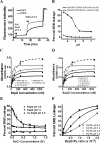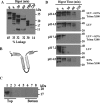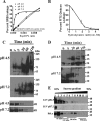Pore-forming Activity of the Escherichia coli Type III Secretion System Protein EspD
- PMID: 26324713
- PMCID: PMC4646203
- DOI: 10.1074/jbc.M115.648204
Pore-forming Activity of the Escherichia coli Type III Secretion System Protein EspD
Abstract
Enterohemorrhagic Escherichia coli is a causative agent of gastrointestinal and diarrheal diseases. Pathogenesis associated with enterohemorrhagic E. coli involves direct delivery of virulence factors from the bacteria into epithelial cell cytosol via a syringe-like organelle known as the type III secretion system. The type III secretion system protein EspD is a critical factor required for formation of a translocation pore on the host cell membrane. Here, we show that recombinant EspD spontaneously integrates into large unilamellar vesicle (LUV) lipid bilayers; however, pore formation required incorporation of anionic phospholipids such as phosphatidylserine and an acidic pH. Leakage assays performed with fluorescent dextrans confirmed that EspD formed a structure with an inner diameter of ∼2.5 nm. Protease mapping indicated that the two transmembrane helical hairpin of EspD penetrated the lipid layer positioning the N- and C-terminal domains on the extralumenal surface of LUVs. Finally, a combination of glutaraldehyde cross-linking and rate zonal centrifugation suggested that EspD in LUV membranes forms an ∼280-320-kDa oligomeric structure consisting of ∼6-7 subunits.
Keywords: EHEC; EPEC; Escherichia coli (E. coli); EspD; bacterial pathogenesis; membrane protein; protein translocation; type III secretion system (T3SS).
© 2015 by The American Society for Biochemistry and Molecular Biology, Inc.
Figures









Similar articles
-
Type Three Secretion System in Attaching and Effacing Pathogens.Front Cell Infect Microbiol. 2016 Oct 21;6:129. doi: 10.3389/fcimb.2016.00129. eCollection 2016. Front Cell Infect Microbiol. 2016. PMID: 27818950 Free PMC article. Review.
-
The N-terminal amphipathic region of the Escherichia coli type III secretion system protein EspD is required for membrane insertion and function.Mol Microbiol. 2011 Aug;81(3):734-50. doi: 10.1111/j.1365-2958.2011.07727.x. Epub 2011 Jun 28. Mol Microbiol. 2011. PMID: 21651628 Free PMC article.
-
The Serine Protease EspC from Enteropathogenic Escherichia coli Regulates Pore Formation and Cytotoxicity Mediated by the Type III Secretion System.PLoS Pathog. 2015 Jul 1;11(7):e1005013. doi: 10.1371/journal.ppat.1005013. eCollection 2015 Jul. PLoS Pathog. 2015. PMID: 26132339 Free PMC article.
-
Coiled-coil domain of enteropathogenic Escherichia coli type III secreted protein EspD is involved in EspA filament-mediated cell attachment and hemolysis.Infect Immun. 2001 Jun;69(6):4055-64. doi: 10.1128/IAI.69.6.4055-4064.2001. Infect Immun. 2001. PMID: 11349076 Free PMC article.
-
Tight Junction Disruption Induced by Type 3 Secretion System Effectors Injected by Enteropathogenic and Enterohemorrhagic Escherichia coli.Front Cell Infect Microbiol. 2016 Aug 24;6:87. doi: 10.3389/fcimb.2016.00087. eCollection 2016. Front Cell Infect Microbiol. 2016. PMID: 27606286 Free PMC article. Review.
Cited by
-
The Edwardsiella piscicida Type III Effector EseJ Suppresses Expression of Type 1 Fimbriae, Leading to Decreased Bacterial Adherence to Host Cells.Infect Immun. 2019 Jun 20;87(7):e00187-19. doi: 10.1128/IAI.00187-19. Print 2019 Jul. Infect Immun. 2019. PMID: 30988056 Free PMC article.
-
Bacterial outer membrane vesicles provide an alternative pathway for trafficking of Escherichia coli O157 type III secreted effectors to epithelial cells.mSphere. 2023 Dec 20;8(6):e0052023. doi: 10.1128/msphere.00520-23. Epub 2023 Nov 6. mSphere. 2023. PMID: 37929984 Free PMC article.
-
Type Three Secretion System in Attaching and Effacing Pathogens.Front Cell Infect Microbiol. 2016 Oct 21;6:129. doi: 10.3389/fcimb.2016.00129. eCollection 2016. Front Cell Infect Microbiol. 2016. PMID: 27818950 Free PMC article. Review.
-
Sequencing of five poultry strains elucidates phylogenetic relationships and divergence in virulence genes in Morganella morganii.BMC Genomics. 2020 Aug 24;21(1):579. doi: 10.1186/s12864-020-07001-2. BMC Genomics. 2020. PMID: 32831012 Free PMC article.
-
The sequence of events of enteropathogenic E. coli's type III secretion system translocon assembly.iScience. 2024 Feb 3;27(3):109108. doi: 10.1016/j.isci.2024.109108. eCollection 2024 Mar 15. iScience. 2024. PMID: 38375228 Free PMC article.
References
-
- Guarner F., Malagelada J. R. (2003) Gut flora in health and disease. Lancet 361, 512–519 - PubMed
-
- Russo T. A., Johnson J. R. (2003) Medical and economic impact of extraintestinal infections due to Escherichia coli: focus on an increasingly important endemic problem. Microbes Infect. 5, 449–456 - PubMed
-
- Kaper J. B., Nataro J. P., Mobley H. L. (2004) Pathogenic Escherichia coli. Nat. Rev. Microbiol. 2, 123–140 - PubMed
Publication types
MeSH terms
Substances
LinkOut - more resources
Full Text Sources

